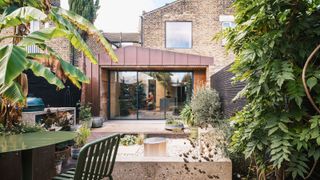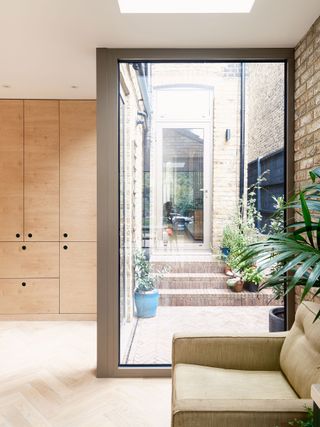Your essential extension planner: A step-by-step guide
About to take on an extension? Our step-by-step extension planner covers everything from breaking ground to final decorative finishes to ensure you understand how to prioritise the construction works and sequence them in the correct order

Using a good extension planner is key to any good, well-organised construction programme. This is an essential management tool for keeping a project on time and on budget.
While building an extension is a different experience for everyone, the type of jobs that need to be completed to get your project from A to B and the order they are best carried out in tend to be very similar.
Construction programmes clearly outline a project’s scope of work, identifying timescales, lead times, development phases and durations, as well as the sequence of activities and the human and material resources needed to reach each milestone. Project budgets and cashflow can also be incorporated to assist with financial control.
For an extension or remodelling project, there is a logical sequence of works, which should be adhered to in any programme in order to avoid wasting time and money
as a result of undertaking tasks in the wrong order, and having to undo completed work. Here’s a step-by-step basic programme of works for a renovation or extension project:
How to use this extension planner
The extension schedule here is based on a single storey kitchen extension. This should give you a good idea of how long an extension takes, allowing you to scale up, or down, accordingly.
Obviously smaller kitchen extensions are just one type of project and if you are carrying out a two storey extension, bear in mind that it is likely to take between three to five weeks longer than the average single storey design. In addition, if you plan on living in the property while building work goes on around you, things are likely to take longer.
Under each stage is a list of the jobs involved and any others that might be going on at the same time. By bearing this in mind it should be easier to work out what trades will be on site simultaneously. It should also give you an idea of where your budget will be being spent and when funds need to be available.
Before getting started, do be sure to check that your existing home insurance policy covers any works undertaken as part of an extension project. Avoid any nasty (and expensive) surprises later down the line by getting in touch with your insurance provider and checking what is and isn't covered.
To make sure your home is properly insured during substantial home improvements, you’ll often need a specialist policy, such as those offered by Self Build Zone
1. Secure the site and insure
Before starting, ensure you have given appropriate consideration to the level of pre-construction information required for the scope and scale of the project.
Also ensure you’ve discharged any ‘pre-commencement’ planning conditions before work begins on site. Planning conditions can be areas related to service connections, trees or access and have to be resolved before building begins, otherwise you could face enforcement action.
Check that your existing home insurance policy covers any works that are undertaken as part of an extension project. Avoid any nasty (and expensive) surprises later down the line by getting in touch with your insurance provider and checking what is and isn’t covered.
2. Stabilise the building and make safe
In the case of those adding an extension while renovating a house, before any works commence, the building needs to be made safe, as it will become a ‘place
of work’ if you employ a builder or any tradespeople, or have anyone else helping you on site. This means cutting off the power and water to any building services to be removed, and providing temporary power and water supplies for the construction works as part of the ‘site setup’.
Undertaking an asbestos survey is essential in order to ensure the building is free of potentially life-threatening contamination. Any asbestos found must be removed safely in accordance with guidance from the Health and Safety Executive (HSE), which you can find at www.hse.gov.uk/asbestos/
3. Strip back and salvage whatever can be reused
Once the site is safe, any demolition work can be undertaken to dismantle parts of the building that are being removed or altered. Used building materials often have value and salvaging them for reuse on your site, or selling them for reuse elsewhere through a salvage yard will help with the sustainability of the project.
A demolition contractor will usually be prepared to offset some of the cost of their work against the value of salvaged materials.
A ‘soft strip out’ contract is often the first stage of a more extensive renovation or extension project and can involve the removal of all old building services (wiring, heating and plumbing), stripping old decorative finishes back to plasterwork, or the removal of plaster back to the brick or masonry to facilitate the repairs and rebuilding work.
This stage will usually involve scaffolding to provide access. If a full scaffold is required to cover all or part of the building due to removal of the roof, a structural engineer’s design is a legal requirement.
Be sure to notify the local authority of the demolition works.
4. Treat for rot, damp treatments etc.
Before or alongside undertaking building work to alter or extend the superstructure, it is important to solve any issues such as rising damp, insect infestation and fungal infestation. It is especially important to remove all timber elements affected by ‘dry rot’ and to treat the building with appropriate fungicide.
Unlike the less dangerous wet rot, dry rot is able to spread through damp brickwork and into plaster, allowing it to spread throughout a building with ease. It is one of the most difficult types of rot to treat and can even lead to timber and brickwork collapsing in extreme cases.
Although damp treatments, insecticide and fungicide are all available on the DIY market, it is best to leave this work to specialist contractors that will provide an insurance-backed guarantee.
5. Undertake all major building work to walls, floors and roof
This is the main part of the building contract and involves the heavy building work to add your extension or undertake the remodelling work. It includes the groundworks, foundations, wall and roof construction to form the completed superstructure for your home). These works will involve groundworkers, bricklayers, carpenters, roofers and general building operatives to install drainage and service risers, insulation etc. Once the roof covering is completed and any external cladding done, the gutters and downpipes (rainwater goods) can be fitted and any external decoration and mastic sealing work undertaken. The scaffold can then be dropped.
Works to connect any new drainage runs to the existing drainage network will usually be left until the heavy building work is complete and the scaffold has been dropped.

6. Make the building ‘shell’ weathertight
Before internal works commence the building should be made secure and weathertight. This means the roof is completed (at least covered if not fully tiled) and all window and door openings are closed up. In most cases this will mean the roof is tiled and the doors and windows are installed fully glazed, but if these are not yet on site, or the glazing is considered to be too vulnerable to install while works are still underway, then temporary works can be used to close up the building.
To accelerate a building programme, it is possible to make parts of a building weathertight e.g. often the top attic storey or upstairs storey, and to seal it off
and commence first fix while the heavy building work continues on lower storeys.
Often, home improvement projects such as extensions and loft conversions are made weathertight and then completed to plastered-out stage before the demolition work to ‘knock through’ to the existing dwelling is undertaken. This can be an excellent way to separate building works from the existing home, especially if you are still living in the property during the project. During the knock through stage it is best to move out for a few days or one to two weeks.
7. First fix carpentry, plumbing, electrics, mechanical and ventilation etc.
This stage involves all of the internal works that need to be completed prior to screeding the floors and plastering the walls. Insulation and buildings services (wiring, plumbing, heating pipework and control wiring, mechanical ventilation will all be concealed by the screed and plaster finishes). It is therefore essential to have finalised all buildings service layouts prior to starting the first fix stage. This means designing a kitchen and the choosing all appliances, the layout and choice of sanitaryware and brassware (taps and showers etc) and the position of radiators and towel rails.
Ahead of commencing first fix, all stud partition walls (timber or metal studwork that will be finished with plasterboard later, as opposed to solid masonry walls) need to be completed.
First fix also includes fitting the door and window linings around openings so that plasterers have a profile to work to.
External power supply for outdoor lighting, electric gates, water features etc, need to be in place at the first fix stage, together with any indoor switches that
need fitting.
8. Plastering and repair plaster
This is the stage that begins to transform a building site into something resembling a home. Ahead of the plastering walls and floors, the floors will be screeded to the levels ready for the floor finishes. Before the screeding commences it is essential to have chosen all the floor finishes to ensure the screed levels account for the depth of the different finishes e.g. flagstones, tiles, wooden flooring, carpet, lino etc.
Ahead of the plasterers commencing work, each room will be prepped, the beads (stop bead, angle bead, shadow gap bead) fitted and wire mesh and scrim used to close up any gaps. Any existing plasterwork that requires repair, or a new skim
coat of finishing plaster will be prepared, too.
The ceilings are battened out and sheets of plasterboard screwed into position (known as ‘tacking’ work). Stud walls are also plasterboarded ready for taping and jointing (using feather-edged plasterboard) or finished with a skim coat of fine gypsum plaster (using square-edged plasterboard). Shower enclosures and wet areas are finished with a waterproof tile backing board.
The plasterers will work through the home room by room, starting with the ceilings and moving into the walls. They will leave behind beautifully smooth polished surfaces (unless you specify a more rustic finish for a cottage or farmhouse) with sharp angles around openings and external corners (arises).
Any decorative plasterwork, such as coving, cornice, ceiling roses etc, can then be applied.
Whether or not the stairs are installed at this stage is a difficult decision. Plastering to the strings can give a better finish, but it is difficult to protect the stairs from damage at this stage of a project, so if an expensive staircase has been selected, with oak treads etc, it is best to leave installation to second fix stage unless it can be fully protected from water and paint spills and heavy traffic.

9. Lay fixed flooring and tile bathrooms (not carpets)
Before second fix (installing skirting and architrave, hanging doors, and fitting sanitaryware etc) all fixed flooring needs to be laid. This includes tiled and most types of wood flooring, but not soft floor coverings like carpet or lino etc. All floor finishes need to be protected so they are not damaged by foot traffic, or covered in paint from the decorating stage. Wooden flooring should not be laid until the screed substrate has dried out fully and the moisture level reading is in line with the manufacturer’s guidance.
10. Second fix carpentry, plumbing, electrics, mechanical and ventilation etc
Prior to this stage, it is common practice to prime all the fresh plasterwork as soon as it has dried out with a mist coat (watered-down emulsion), which ensures adhesion of the paint finishes. It is quicker to apply this with a roller without worrying about other finished surfaces.
Second fix includes jobs like hanging the internal doors; fitting ironmongery (handles and knobs etc,); fixing architrave and skirting, window board/cills; fitting timber panelling or other decorative details; fitting a kitchen and templating for worktops and splashbacks; fitting hearths as well as fireplaces and woodburning stoves; sanitaryware and brassware (taps and showers etc) including radiators and towel rails; faceplates to sockets and switches; ceiling and wall lights; and fitting and commissioning security alarm and/or
CCTV systems.
11. Decorate and fill
This stage transforms the building site into a home, but to get a high-quality finish the work is 80% preparation and only 20% painting. Plaster finishes need to be rubbed down and filled. Timber finishes need to be rubbed down, knotted, filled and primed. MDF surfaces need to be primed. Paintwork will need to be built up in 2-3 coats and carefully cut in. Sloping ceilings are best painted in the same colour as the walls so as to avoid difficulties in cutting in a straight line.
This stage also involves applying mastic sealant to bathrooms, kitchen worktops and hearths, as well as the filling of any other gaps or areas that might require waterproofing.
External decoration should have been completed while the scaffold was still up, but at this stage it is normal to complete external mastic work to fill around doors and windows, expansion joints etc.
12. Landscape the garden (at any stage after scaffolding is dropped)
The structural landscaping work to form the contours of the garden, the driveway design and paths should all have been completed while there was heavy machinery on site, but this is not always practical, especially on a tight site.
Once the scaffolding has been taken down, you can complete paths and driveway surfaces; lawns and beds can be screened to remove stones, levelled and topsoil spread and levelled; you can plant trees and shrubs; seed lawns or lay turf and install garden lighting.
13. Practical completion
Practical completion is typically defined as the point when the building work is complete — save for any minor defects — and you can take possession back from the builder and move in. At this stage you should expect to receive all manufacturers’ and installers’ guarantees, commissioning certificates, and Electrical Installation Certificate. Whoever is dealing with building control will need to provide all of the information required to get a Completion Certificate, and this will include the ‘as built’ Energy Performance Certificate (EPC).
If there is a retention clause in your building contract, 50% of the retention monies held against defects will be released now.
14. Snagging work
Once work is finished, it is important to write up a snagging list. Any leaks, problems with electrics and sticking doors and windows need to be reported to the relevant trade as soon as possible after finishing.
If you have used a main contractor there will be a defects liability clause in the contract and a payment retention. This is to ensure that the builder returns to complete defects work, usually six months following practical completion. Once the works have been completed, the remaining balance of retention monies
can then be released.
If you have managed the project yourself, then the cost of correcting any defects will be down to you unless you have agreed a retention with individual subcontractors.
All building work undertaken is still covered by consumer law.

As well as running an architectural and interior design practice, Michael is a TV presenter and author.
Get the Homebuilding & Renovating Newsletter
Bring your dream home to life with expert advice, how to guides and design inspiration. Sign up for our newsletter and get two free tickets to a Homebuilding & Renovating Show near you.
Michael is Homebuilding & Renovating's Director of Content, Vice Chair of the self build industry body, the National Custom and Self Build Association (NaCSBA), presenter of multiple property TV shows and author of Renovating for Profit (Ebury). He also runs an architectural and interior design practice, offering design and project management services. He is one of the country's leading property experts and has undertaken over 30 building projects including two self-builds and the renovation of a Grade-II listed farmhouse.
Michael has presented over 150 property shows for BBC, ITV1, Channel 5, UK TV Style, and Discovery RealTime, including I Own Britain's Best Home; Don't Move Improve; Trading Up; Good Bid, Good Buy; Build, Buy or Restore?; How to Build A House; and Hard Sell.
Michael is also a regular expert at the Homebuilding & Renovating Shows. He has written for leading British newspapers, including The Daily Telegraph, Sunday Times, Daily Express and The Independent and has appeared on news programmes such as BBC Breakfast.
